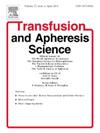Refractory delayed-onset heparin induced thrombocytopenia (HIT) without thrombosis, treated with intravenous immunoglobulin
IF 1.4
4区 医学
Q4 HEMATOLOGY
引用次数: 0
Abstract
Heparin-induced thrombocytopenia (HIT) is a platelet activation syndrome characterized by the sudden onset of thrombocytopenia and/or thrombosis, induced by anti-platelet factor 4 (PF4)/heparin antibodies that cause platelet activation and destruction. Delayed-onset heparin-induced thrombocytopenia is a variant of HIT that occurs in less than 5 % of cases and is characterized by the onset of thrombocytopenia and/or thrombosis several days after heparin discontinuation. With treatment, the platelet count usually recovers within a week, but in up to 1 % of patients, thrombocytopenia persists for several weeks or months, which is referred to as refractory (persisting) HIT. Refractory delayed-onset HIT represents an important clinical entity because of its potential complications as well as the challenges and complexities in diagnostics and treatment. In the following case report, we present a case of a 69-year-old man diagnosed with refractory delayed-onset HIT, confirmed by a functional assay for platelet-activating anti-PF4/heparin antibodies, who prolonged platelet count recovery without evident signs of thrombosis and was successfully treated with intravenous immunoglobulin (IVIG). This case report provides important clinical and laboratory data necessary for the timely recognition, diagnosis, and treatment of refractory delayed-onset HIT. It also emphasizes the need to consider HIT variants and highlights the importance of early recognition and treatment to minimize complications such as thrombosis and bleeding.
使用静脉注射免疫球蛋白治疗的无血栓形成的难治性迟发性肝素诱导性血小板减少症(HIT)
肝素诱导的血小板减少症(HIT)是一种血小板活化综合征,其特征是血小板减少症和/或血栓形成的突然发作,由抗血小板因子4 (PF4)/肝素抗体引起血小板活化和破坏。迟发性肝素诱导的血小板减少症是HIT的一种变体,发生在不到5% %的病例中,其特征是在肝素停药后几天出现血小板减少和/或血栓形成。通过治疗,血小板计数通常在一周内恢复,但在高达1 %的患者中,血小板减少持续数周或数月,这被称为难治性(持续性)HIT。难治性迟发性HIT由于其潜在的并发症以及诊断和治疗的挑战和复杂性,代表了一个重要的临床实体。在以下病例报告中,我们报告了一位69岁的男性,诊断为难治性迟发性HIT,通过血小板活化抗pf4 /肝素抗体的功能测定证实,他延长了血小板计数恢复,没有明显的血栓迹象,并成功地接受了静脉注射免疫球蛋白(IVIG)治疗。本病例报告为及时识别、诊断和治疗难治性迟发性HIT提供了重要的临床和实验室数据。它还强调需要考虑HIT变异,并强调早期识别和治疗的重要性,以尽量减少血栓和出血等并发症。
本文章由计算机程序翻译,如有差异,请以英文原文为准。
求助全文
约1分钟内获得全文
求助全文
来源期刊
CiteScore
3.60
自引率
5.30%
发文量
181
审稿时长
42 days
期刊介绍:
Transfusion and Apheresis Science brings comprehensive and up-to-date information to physicians and health care professionals involved in the rapidly changing fields of transfusion medicine, hemostasis and apheresis. The journal presents original articles relating to scientific and clinical studies in the areas of immunohematology, transfusion practice, bleeding and thrombotic disorders and both therapeutic and donor apheresis including hematopoietic stem cells. Topics covered include the collection and processing of blood, compatibility testing and guidelines for the use of blood products, as well as screening for and transmission of blood-borne diseases. All areas of apheresis - therapeutic and collection - are also addressed. We would like to specifically encourage allied health professionals in this area to submit manuscripts that relate to improved patient and donor care, technical aspects and educational issues.
Transfusion and Apheresis Science features a "Theme" section which includes, in each issue, a group of papers designed to review a specific topic of current importance in transfusion and hemostasis for the discussion of topical issues specific to apheresis and focuses on the operators'' viewpoint. Another section is "What''s Happening" which provides informal reporting of activities in the field. In addition, brief case reports and Letters to the Editor, as well as reviews of meetings and events of general interest, and a listing of recent patents make the journal a complete source of information for practitioners of transfusion, hemostasis and apheresis science. Immediate dissemination of important information is ensured by the commitment of Transfusion and Apheresis Science to rapid publication of both symposia and submitted papers.

 求助内容:
求助内容: 应助结果提醒方式:
应助结果提醒方式:


